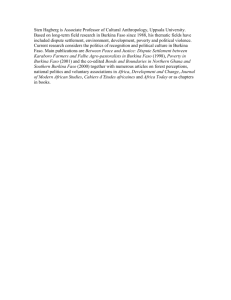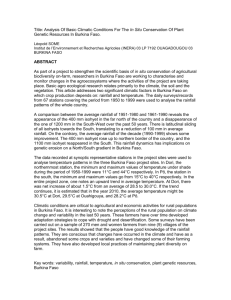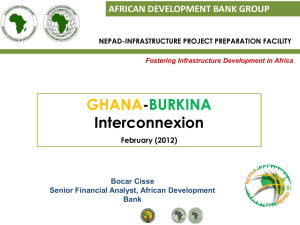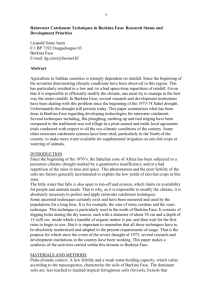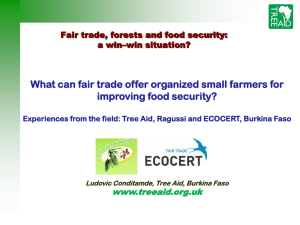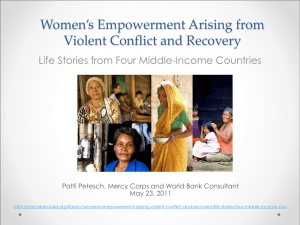Zambrano Patricia
advertisement
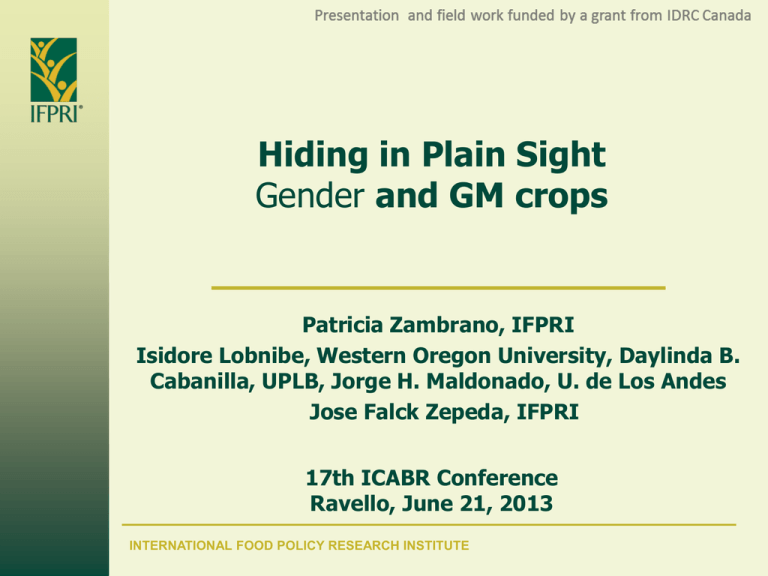
Hiding in Plain Sight Gender and GM crops Patricia Zambrano, IFPRI Isidore Lobnibe, Western Oregon University, Daylinda B. Cabanilla, UPLB, Jorge H. Maldonado, U. de Los Andes Jose Falck Zepeda, IFPRI 17th ICABR Conference Ravello, June 21, 2013 INTERNATIONAL FOOD POLICY RESEARCH INSTITUTE Outline • Is gender relevant? • Why use a qualitative approach? • Burkina Faso, Colombia, and the Philippines gender pilot case studies • Similarities and differences • Future research? • Gender neutral, but mainly male “Farmers” • Household as unit of analysis • Sole and efficient HH decisionmakers Misspecification: Biased and inconsistent models Policy implications Gender • Gender roles are determined by cultural, ideological, religious, economic and social relationship between men and women and affect the distribution of resources between men and women • It is one of the determinants in technology adoption bEcon bEcon Economics Literature about the Impacts of Genetically Engineered Crops in Developing Economies http://ebrary.ifpri.org/cdm/landingpage/collection/p15738coll6 Compiled by Indira Yerramareddy, Patricia Zambrano, and Jose Falck Zepeda Gender and GM Of the 135 papers in bEcon than that assess the economic impact of GM crops on farmers we found only a handful that made explicit references to gender. To explore whether gender affects access to and use of GM cotton, we developed and tested a qualitative approach in Colombia, as well as Burkina Faso and later for GM maize in the Philippines Burkina Faso Lobnibe, I., Zambrano, P., and Biermayr-Jenzano, P. 2012. Field Report on Gender and GM cotton in Burkina Faso. Project report. Washington DC. Colombia Zambrano, P., J. H. Maldonado, S. L. Mendoza, L. Ruiz, L.A. Fonseca, and I. Cardona. 2011. Women cotton farmers: Their perceptions and experiences with transgenic varieties. IFPRI Discussion Paper 01118. Washington, D.C. International Food Policy Research Institute (IFPRI) Zambrano, P., M. Smale, J. H. Maldonado, and S. L. Mendoza. 2012. Unweaving the Threads: The Experiences of Female Farmers with Biotech Cotton in Colombia. AgBioForum 15(2): 125-137 Philippines Yorobe, M., Jr., and D. Cabanilla. 2013. Gender Impacts from the adoption of genetically modified maize in the Philippines. Draft final report submitted to the International Food Policy Research Institute (IFPRI). Project report. Los Banos, the Philippines. Page 8 Economic assessment of commercialized GM crops in Burkina Faso, Colombia, and Philippines Documented economic benefits Absence of gender considerations Page 9 Fieldwork Colombia, 2010 Burkina Faso, 2011 GM cotton Cerete, Cordoba and El Espinal, Tolma Dahoun, Hounde, Dimikuy, and Bereba in Tuy Province Dano in Ioba Province Philippines, 2012 • u GM Maize Barangay Olympog in General Santos City ,South Cotabato, Barangay Cabisera 5 in Ilagan, Isabela 2011 indicators Burkina Faso Colombia Philippines Population, total mill 17.0 46.9 94.9 GDP per capita (constant 2000 US$) 286.1 3,362.5 1,413.4 Urban population (% of total) 26.5 75.3 48.9 Agriculture, value added (% of GDP) 33.8 7.0 12.8 Employment in agriculture (% of total 84.8* 17.9 33.0 79.7 59.4 51.2 51.7 2.5 1.1 employment) Labor force participation rate, female (% of female population ages 15-64) Agricultural raw materials exports (% of merchandise exports) Qualitative Research Design • • • • • Small group discussion (SGD) Participant observation Expert opinion interviews One-to-one interviews Secondary data collection Disclosure Corroboration of the comparative qualitative findings presented here need to be followed up with quantitative studies to confirm the extent and representativeness of these observations. Page 14 Colombia Philippines Access to credit, farm inputs Ability to hire personnel Limited Activity/Issue Burkina Faso Inheritance rights Access to land Granted by head of HH Access to information, extension services Equal partners with head of HH as crop producers Work contribution in HH/male plots Active participation in overall crop operation Invisible or undervalued croprelated activities Limited Limited Limited Control and responsibility over HH finances Control of crop operation Limited A new focus? Access and control of assets are key determinant in technology adoption The comparison between Burkina, and Colombia/Philippines suggests that even when women have such access they still have other binding limitations – Social and cultural norms Time and other limitations Similarities Qualitative methods uncovered many activities that show women involvement in the overall cotton and maize operation GM varieties have introduced changes in farming practices that affect women and men differently Similarities • Overall men and women perceive GM as beneficial • Men and women perceive costs and benefits of GM differently, although women who have planted GM varieties tend to agree more with their male counterparts • Both male and female farmers identified the lack of adequate and timely information about GM as a disadvantage • Lack of knowledge about the technology is more prevalent among female non-adopters than male non-adopters Other similarities For female farmers the fact that GM is a laborsaving technology seems to be the most beneficial Absence of gender considerations aspect of the technologies Differences in how male and female farmers use additional income and time saved that the technology can generate Women’s constraints – Most limiting one appear to be time. Women are constrained by their domestic workload and responsibilities – Limited access to agronomic and technology information, even compared to their male counterparts – Limited or no access or even no knowledge of the technology that can potentially benefit them. Potential areas for future research • Understand the determinants of women versus men’s decision to grow GM crops • Understand heterogeneity among male and female clients • Quantify “invisible threads”: multiple tasks performed by women that are many times perceived as “invisible” or of insignificant social or cultural value • Assess ”indirect “ benefits of GM: reduced drudgery • Assess how women and men spend saved time and additional resources Bt cotton in Burkina Faso, advantages Labor-saving technologies • Reduction in insecticide application from 6 to 2 applications- Some estimates: – Water saved: 18 to 20 gallons of water by ha. – Time saved: Women have saved 3 trips to the well for every savedinsecticide application, for a total of 12 trips or 36 miles – Health implication: Average water weight per trip ~20 kg • • • • Women play an important role in proction Different perceptions] Not all women are the same What youmen and women do with additional resources.
